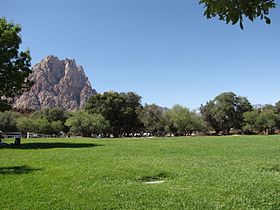Spring Mountain Ranch State Park
| Spring Mountain Ranch State Park | |
| Nevada State Park | |
|
A field in Spring Mountain Ranch State Park
|
|
| Country | |
|---|---|
| State | |
| County | Clark |
| Nearest town | Blue Diamond |
| Elevation | 3,727 ft (1,136 m) |
| Coordinates | 36°04′11″N 115°27′2″W / 36.06972°N 115.45056°WCoordinates: 36°04′11″N 115°27′2″W / 36.06972°N 115.45056°W |
| Area | 520 acres (210 ha) |
| Founded | 1974 |
| Management | Nevada Division of State Parks |
| Website: Spring Mountain Ranch State Park | |
Spring Mountain Ranch State Park is a public recreation area preserving the historic Sandstone Ranch 5 miles (8.0 km) northwest of Blue Diamond, Nevada. The state park is located within the Red Rock Canyon National Conservation Area in Nevada's Cottonwood Valley.
In the mid-1830s, a campsite was established along the wash that runs through the ranch. The spring-fed creek and grassy meadows formed an oasis for travelers using the alternate route of the Spanish Trail through Cottonwood Valley. The use of the site by pack and wagon trains continued until their replacement by the railroad in 1905. This remote trail was also used extensively by outlaws involved in Indian slave trading, horse stealing and raids upon passing caravans. In 1840, a group of American mountain men and Ute Indians conducted a famous raid on the Mexican Ranchos in California. Mountain Man Bill Williams, a member of the raiding party, brought his band of horses through Red Rock Canyon where he rested the horses from the hard trip across the desert. Apparently he revisited the area several times and for many years afterwards the site of Spring Mountain Ranch was known as the "Old Bill Williams Ranch".
Sand Stone Ranch, as it was first known, was formed in 1876 by Sergeant James B. Wilson and George Anderson. The ranch under this name was listed on the United States National Register of Historic Places on April 3, 1976.
Because of the higher elevation, the ranch offers a diverse opportunity for plant study. Four plant communities are represented: Desert Scrub, Black brush, Pinon-Juniper, and Riparian. Plants typical of the desert as well as woodland can be seen, and with adequate rainfall the spring brings a burst of wildflowers. Common species sighted are desert marigold, globe mallow, brittlebush, Joshua Tree, Mohave Yucca, and indigo bush. Animal life is diverse but nocturnal, so many species go unseen. Typical desert animals include a variety of lizards and snakes, antelope, ground squirrels, jackrabbits, cottontail rabbits, kit foxes, and coyotes. Higher elevation species include rock squirrel, badger, mule deer, and bighorn sheep.
...
Wikipedia




